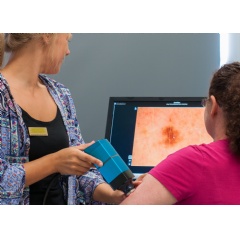Molemap For Melanoma Skin Cancer
Mole mapping is the most effective surveillance program for detecting melanoma skin cancer. A molemap involves digital comparisons of existing moles and total body photography. A molemap will detect changing moles, an indicator for melanoma and a molemap will also detect new moles. Most melanomas occur as a new mole rather than developing in an existing mole. All patients at increased risk for melanoma skin cancer should have molemap surveillance.

Mole mapping is the most effective surveillance program for detecting melanoma. A molemap detects new and changing moles, both indicators for melanoma.
Melanoma is the most dangerous skin cancer. Although only representing 2% of all skin cancers, it is responsible for 75% of all skin cancer deaths. Early detection is vital for a good survival rate. Mole mapping is most effective method for detecting melanoma early.
The biggest risk factor for melanoma is having a large number of moles that can include some large atypical moles. When a patient has many moles, personal observation for new or changing lesions can become an almost insurmountable task. Mole mapping is a surveillance program that covers all aspects for detecting melanoma.
Mole mapping involves magnified digital comparisons of selected moles to detect any changes and also total body photography. Total body photography requires high resolution photos to be taken of all areas of the body. These photos are then used at follow-up appointments, to detect new moles, when doing a full skin examination.
“The introduction of dermoscopy, a non-invasive diagnostic technique, enables us to visualise the microscopic structures within the skin to diagnose skin cancers at a much earlier stage” stated Dr Sally Shaw, skin cancer expert at Peninsula Skin Cancer Centre.
“We use Molemax digital imagery to detect any change within a suspicious mole and also to recognise something new” said Dr Shaw. “Although we can continue to develop new benign moles up until the age of 40, any new mole in an adult should be monitored as they may be melanoma”.
“If a mole shows a change in structure, colour or size, then a biopsy is required to rule out melanoma. However, if a mole shows no changes, then it is unlikely to be melanoma and can continue to be monitored. Mole mapping enables us to see these changes before they are visible to the naked eye” she said.
Mole mapping is a service available at Peninsula Skin Cancer Centre. It usually requires an hour long appointment. No referral required.
Click here for more information on Mole Mapping.
( Press Release Image: https://photos.webwire.com/prmedia/50016/203838/203838-1.jpg )
WebWireID203838
- Contact Information
- Sue Dixon
- Marketing Manager
- Peninsula Skin Cancer Centre
- Contact via E-mail
This news content may be integrated into any legitimate news gathering and publishing effort. Linking is permitted.
News Release Distribution and Press Release Distribution Services Provided by WebWire.